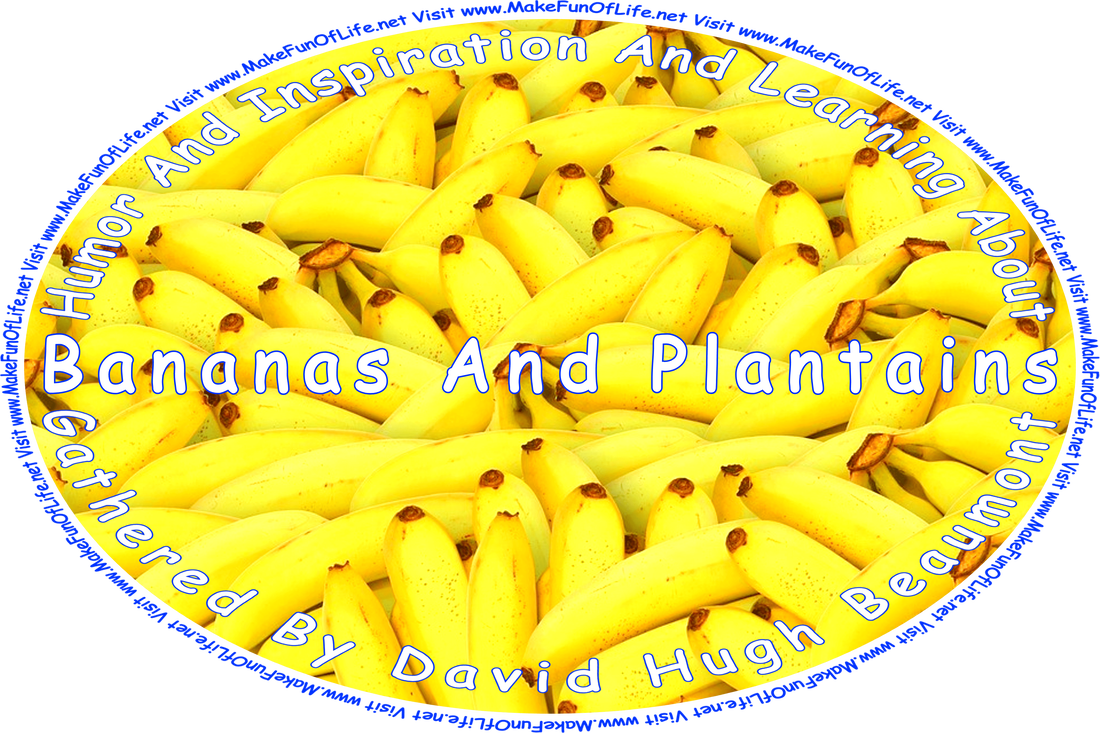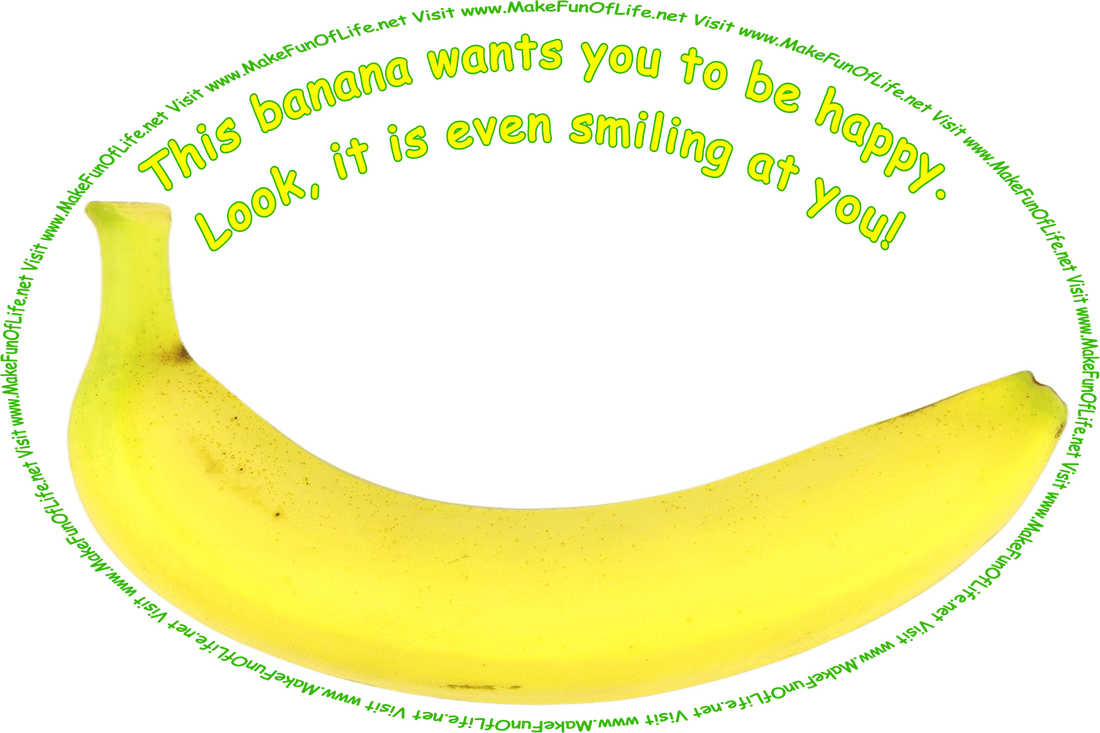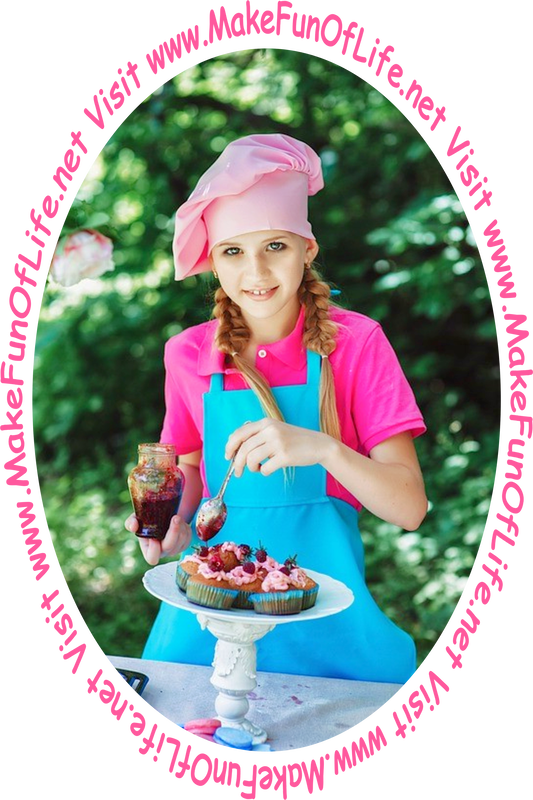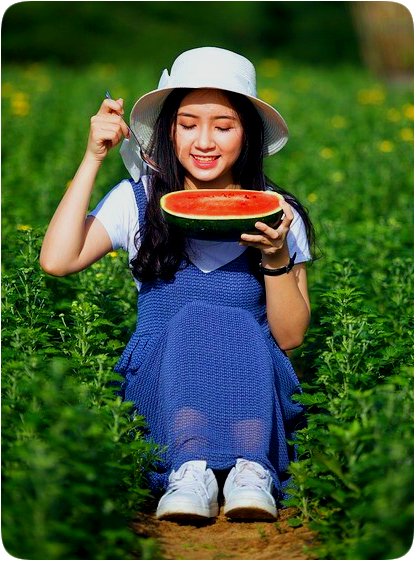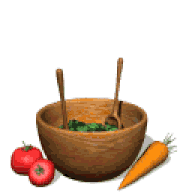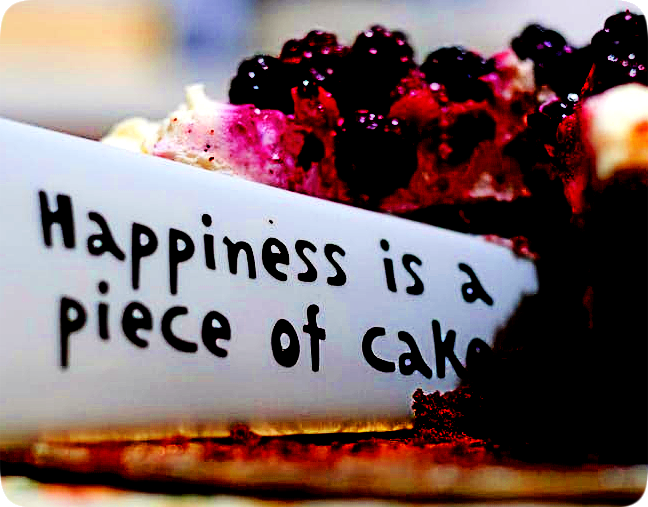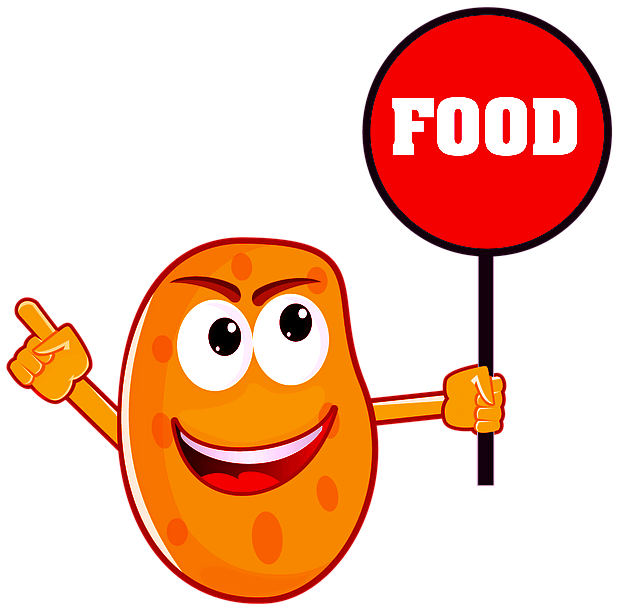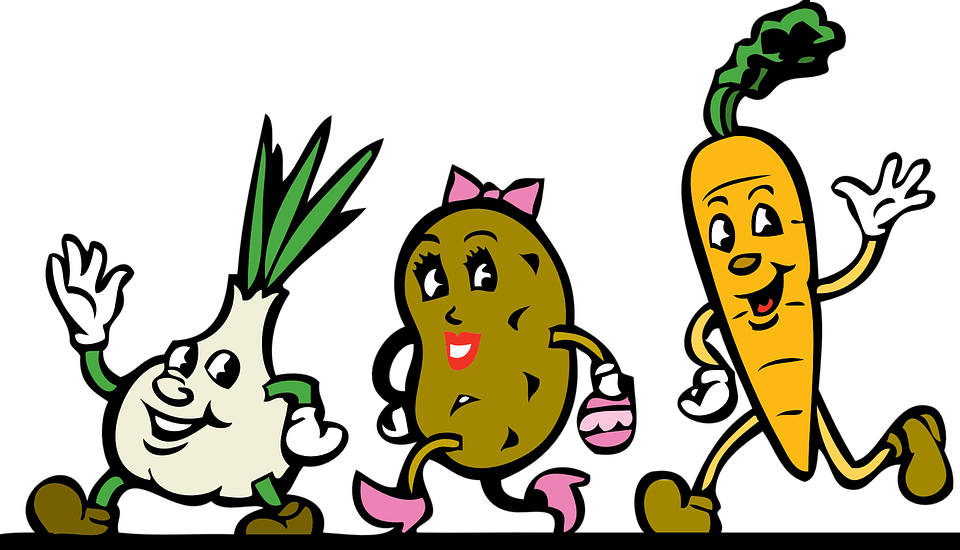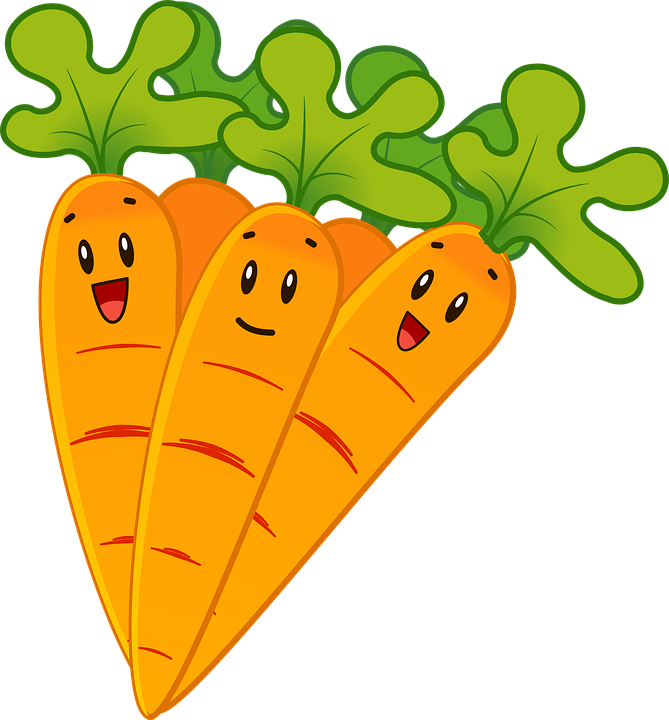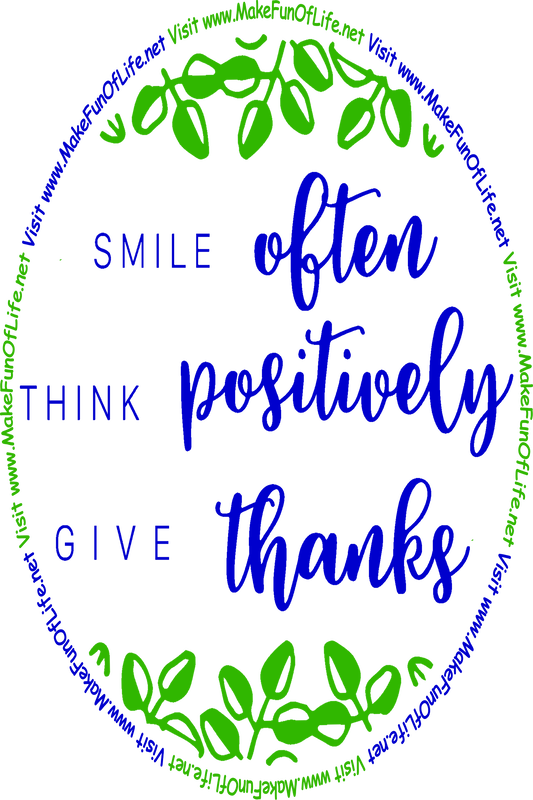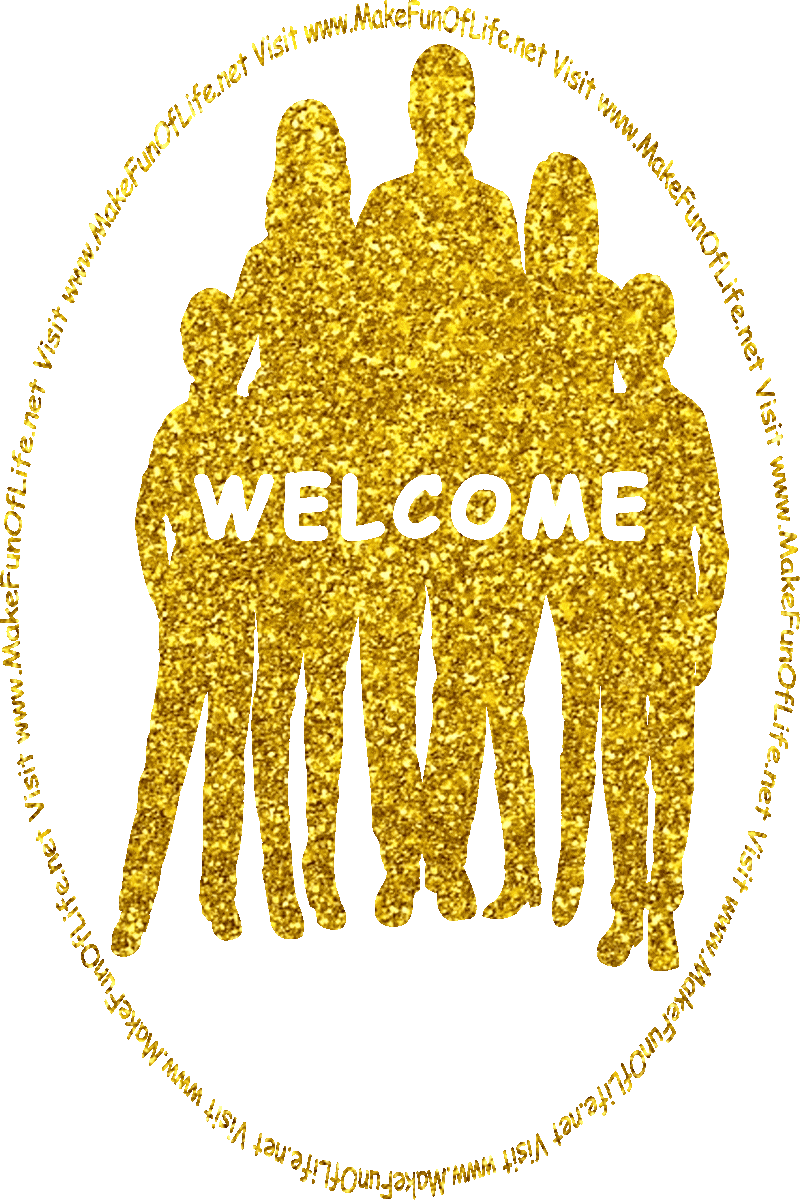Please join us as we attempt to discover why people everywhere seem to be going bananas . . .
“I am going bananas. That’s what I say to my bananas before I leave the house.” -Author Unknown
Continue scrolling down this website page to read the rest of the article, or click or tap on these words to read “Fun and Learning about Meeting and Parting” gathered by David Hugh Beaumont.
Bradly: What do you call a banana that plays the trumpet?
Dylan: A tooty-fruity.
Continue scrolling down this website page to read the rest of the article, or click or tap on these words to read “Fun And Learning About Music” Gathered By David Hugh Beaumont.
Some horticulturists believe that bananas were the Earth’s very first fruit, and they may have been the first fruit plant cultivated by humans, many thousands of years ago. One of the earliest known written records of bananas dates back to the time of Alexander the Great’s conquest of India in 327 B.C.E. Banana plants have been traced back to the Malaysian jungles of Southeast Asia, where many varieties and names for the banana are found. In 1516, Friar Tomàs de Berlanga sailed to the Caribbean, carrying the roots of banana plants with him. Upon his arrival, he planted bananas in the ground, thus beginning the banana plant’s future in the New World.
Continue scrolling down this website page to read the rest of the article, or click or tap on these words to read “Fun And Learning About History” Gathered By David Hugh Beaumont.
Goblin: What do you call a scary banana?
Spook: A boo-nana.
Continue scrolling down this website page to read the rest of the article, or click or tap on these words to read “Humor And Inspiration And Learning About Ghosts And Apparitions” Gathered By David Hugh Beaumont.
Bananas are grown for export in Latin American and South American countries including Brazil, Costa Rica, Ecuador, Colombia, Honduras, Panama, and Guatemala, where the climate and soil conditions are favorable to their growth. Bananas are a common food crop in Africa. Bananas are also grown in parts of India and China, which are now the world’s two top producers of bananas.
Continue scrolling down this website page to read the rest of the article, or click or tap on these words to read “Fun and Learning about Geography” gathered by David Hugh Beaumont.
Jillian: Why did the monkey like the banana?
William: Because he thought the banana had lots of ‘appeal.’
Continue scrolling down this website page to read the rest of the article, or click or tap on these words to read “Fun and Learning about Appearances and Looks” gathered by David Hugh Beaumont.
Occasionally, bananas arriving in the countries to which they are shipped are found to be harboring spiders such as tarantulas, snakes, and other tropical creatures. Buy a bunch of bananas, and maybe you will get a free pet, too - if you are lucky!
The highest average per capita consumption of bananas in the world is in Uganda, where residents eat an average of 227 kilograms (500 pounds) of bananas per person each year. Bananas are such an important part of the diet of Ugandans that their single word ‘matooke’ has come to mean both ‘banana’ and ‘food.’
Julian: What did the banana say to the elephant?
Julius: Nothing - bananas cannot talk.
Continue scrolling down this website page to read the rest of the article, or click or tap on these words to read “Fun and Learning about Conversations and Spoken Communications” gathered by David Hugh Beaumont.
In Southeast Asia, banana leaves are used to wrap food, instead of plastic wrap, providing a unique flavor and aroma to nasi lemak and Indian banana leaf rice. Banana leaf packaging is completely natural and fully biodegradable, meaning it is not harmful to the environment.
Ken: What is long and yellow and always points north?
Len: A magnetic banana.
The Banana Club Museum, located on Highway 111 in Mecca, California, United States of America, houses the world’s largest collection of items devoted to a single fruit. They have more than 17,000 banana items, most of which have been donated by members. To join the club, visit www.bananaclub.com.
Banana plants are scientifically classified in the genus Musa of the Musaceae family. They belong to the same family as lilies, orchids, and palms. The scientific name for banana is ‘musa sapientum’ meaning ‘fruit of the wise men.’
“Life is full of banana skins. You slip, you carry on.” -Daphne Guinness
Continue scrolling down this website page to read the rest of the article, or click or tap on these words to read “Fun and Learning about Life and Living” gathered by David Hugh Beaumont.
Because banana plants are herbaceous plants, they do not have woody stems, or trunks and branches, like trees have, and all their plant matter above the ground decays back into the soil at the end of each annual, or yearly, cycle. However, the part of the plants that is below the ground survives from year to year, and can be hundreds of years old. Although some types of wild bananas grow large, hard seeds, domestic banana plants, from which come the bananas we buy in markets and grocer stores, do not grow from seeds but rather from corms that grow below the ground. Corms are also known as rhizomes or bulbs, and are sometimes referred to by the simplistic term ‘roots,’ although in the case of the banana plants, they are specialized stems of the plants. Banana plant corms look like brown balls, and are about 25 centimeters (10 inches) in diameter. New offshoots, or the part of the plants that grows above the ground, develop from the corms year after year.
Erma: Why do bananas never get lonely?
Emma: Because they go around in bunches.
Continue scrolling down this website page to read the rest of the article, or click or tap on these words to read “Humor And Inspiration And Learning About Loneliness And Solitude” Gathered By David Hugh Beaumont.
The Washington Banana Museum in Auburn, Washington, United States of America is dedicated to bananas. Visit: https://www.bananamuseum.com/.
“I am going bananas. That’s what I say to my bananas before I leave the house.” -Author Unknown
Continue scrolling down this website page to read the rest of the article, or click or tap on these words to read “Fun and Learning about Meeting and Parting” gathered by David Hugh Beaumont.
Bradly: What do you call a banana that plays the trumpet?
Dylan: A tooty-fruity.
Continue scrolling down this website page to read the rest of the article, or click or tap on these words to read “Fun And Learning About Music” Gathered By David Hugh Beaumont.
Some horticulturists believe that bananas were the Earth’s very first fruit, and they may have been the first fruit plant cultivated by humans, many thousands of years ago. One of the earliest known written records of bananas dates back to the time of Alexander the Great’s conquest of India in 327 B.C.E. Banana plants have been traced back to the Malaysian jungles of Southeast Asia, where many varieties and names for the banana are found. In 1516, Friar Tomàs de Berlanga sailed to the Caribbean, carrying the roots of banana plants with him. Upon his arrival, he planted bananas in the ground, thus beginning the banana plant’s future in the New World.
Continue scrolling down this website page to read the rest of the article, or click or tap on these words to read “Fun And Learning About History” Gathered By David Hugh Beaumont.
Goblin: What do you call a scary banana?
Spook: A boo-nana.
Continue scrolling down this website page to read the rest of the article, or click or tap on these words to read “Humor And Inspiration And Learning About Ghosts And Apparitions” Gathered By David Hugh Beaumont.
Bananas are grown for export in Latin American and South American countries including Brazil, Costa Rica, Ecuador, Colombia, Honduras, Panama, and Guatemala, where the climate and soil conditions are favorable to their growth. Bananas are a common food crop in Africa. Bananas are also grown in parts of India and China, which are now the world’s two top producers of bananas.
Continue scrolling down this website page to read the rest of the article, or click or tap on these words to read “Fun and Learning about Geography” gathered by David Hugh Beaumont.
Jillian: Why did the monkey like the banana?
William: Because he thought the banana had lots of ‘appeal.’
Continue scrolling down this website page to read the rest of the article, or click or tap on these words to read “Fun and Learning about Appearances and Looks” gathered by David Hugh Beaumont.
Occasionally, bananas arriving in the countries to which they are shipped are found to be harboring spiders such as tarantulas, snakes, and other tropical creatures. Buy a bunch of bananas, and maybe you will get a free pet, too - if you are lucky!
The highest average per capita consumption of bananas in the world is in Uganda, where residents eat an average of 227 kilograms (500 pounds) of bananas per person each year. Bananas are such an important part of the diet of Ugandans that their single word ‘matooke’ has come to mean both ‘banana’ and ‘food.’
Julian: What did the banana say to the elephant?
Julius: Nothing - bananas cannot talk.
Continue scrolling down this website page to read the rest of the article, or click or tap on these words to read “Fun and Learning about Conversations and Spoken Communications” gathered by David Hugh Beaumont.
In Southeast Asia, banana leaves are used to wrap food, instead of plastic wrap, providing a unique flavor and aroma to nasi lemak and Indian banana leaf rice. Banana leaf packaging is completely natural and fully biodegradable, meaning it is not harmful to the environment.
Ken: What is long and yellow and always points north?
Len: A magnetic banana.
The Banana Club Museum, located on Highway 111 in Mecca, California, United States of America, houses the world’s largest collection of items devoted to a single fruit. They have more than 17,000 banana items, most of which have been donated by members. To join the club, visit www.bananaclub.com.
Banana plants are scientifically classified in the genus Musa of the Musaceae family. They belong to the same family as lilies, orchids, and palms. The scientific name for banana is ‘musa sapientum’ meaning ‘fruit of the wise men.’
“Life is full of banana skins. You slip, you carry on.” -Daphne Guinness
Continue scrolling down this website page to read the rest of the article, or click or tap on these words to read “Fun and Learning about Life and Living” gathered by David Hugh Beaumont.
Because banana plants are herbaceous plants, they do not have woody stems, or trunks and branches, like trees have, and all their plant matter above the ground decays back into the soil at the end of each annual, or yearly, cycle. However, the part of the plants that is below the ground survives from year to year, and can be hundreds of years old. Although some types of wild bananas grow large, hard seeds, domestic banana plants, from which come the bananas we buy in markets and grocer stores, do not grow from seeds but rather from corms that grow below the ground. Corms are also known as rhizomes or bulbs, and are sometimes referred to by the simplistic term ‘roots,’ although in the case of the banana plants, they are specialized stems of the plants. Banana plant corms look like brown balls, and are about 25 centimeters (10 inches) in diameter. New offshoots, or the part of the plants that grows above the ground, develop from the corms year after year.
Erma: Why do bananas never get lonely?
Emma: Because they go around in bunches.
Continue scrolling down this website page to read the rest of the article, or click or tap on these words to read “Humor And Inspiration And Learning About Loneliness And Solitude” Gathered By David Hugh Beaumont.
The Washington Banana Museum in Auburn, Washington, United States of America is dedicated to bananas. Visit: https://www.bananamuseum.com/.
Bananas grow on tropical plants that can be easily mistaken for trees, due to their large size and height, but are actually the world’s largest herbaceous plants, or herbs, and banana fruits are classified botanically as berries. What may seem to be banana plant trunks are sheaths, or stems, formed by tightly wrapped overlapping leaves. Their central stems can grow to be 6 to 7.6 meters (20 to 25 feet) tall, and their leaves can grow up to 2.7 meters (9 feet) long.
Wally: They are not going to grow bananas any longer.
Walter: Really - why not?
Wally: Because they are long enough already!
The yellow Cavendish banana is the most popular variety of banana in the world. It is the banana most often seen in American and European markets. Before the Cavendish, the Gros Michel was the main type of banana that was exported on a large scale. In the 1950’s, the Gros Michel was ravaged by Panama disease and is no longer sold commercially. Panama disease, also known as Fusarium wilt, is a fungus that attacks the roots of banana plants. It was initially reported in Australia in the nineteenth century. The Cavendish banana is resistant to the strain of Panama disease that effectively wiped out the Gros Michel banana, and is safe for now; however, it is believed that the Cavendish, like the Gros Michel, will eventually be devastated by Panama disease and someday will no longer be produced commercially. This could happen within twenty years, and it would be a major blow to the banana industry. Scientists are now trying to develop a hybrid, disease-resistant banana.
Ruby: How do you make a banana split?
Jade: Sneak up on a banana and shout, “Boo!”
Continue scrolling down this website page to read the rest of the article, or click or tap on these words to read “Fun and Learning about Fears and Courage” gathered by David Hugh Beaumont.
The Cavendish is a shorter, stubbier plant than earlier varieties. It was developed to resist plant diseases, insects, and windstorms better than its predecessors did. The fruit of the Cavendish plant is of medium size, with a creamier texture and a thinner peel than some other varieties. Although the yellow Cavendish variety is the banana most commonly seen in markets around the world, sweet bananas come in a variety of colors, including green, yellow, red, purple, and brown. Among varieties of wild bananas are found bubblegum pink bananas with fuzzy skins, green-and-white striped bananas with pulp the color of orange sherbet, and red bananas with reddish-purple skin, which are said to taste like strawberries when cooked. Among the most common types of bananas are the Dwarf Cavendish, the Valery, and the Williams Hybrid bananas. Other types of bananas include Apple and the small red banana called the Red Jamaica. Lady Finger bananas are small, sweet, and have relatively thin skins. More than 500 varieties of bananas exist.
Continue scrolling down this website page to read the rest of the article, or click or tap on these words to read “Fun and Learning about Differences and Individuality” gathered by David Hugh Beaumont.
“On a traffic light, yellow means yield, and green means go, and red means stop. On a banana, it’s just the opposite: yellow means go ahead, green means stop, and red means, where’d you get that banana?” -Mitch Hedberg (1968 - 2005)
Continue scrolling down this website page to read the rest of the article, or click or tap on these words to read “Fun and Learning about Mitch Hedberg” gathered by David Hugh Beaumont.
Bananas are one of the few fruits that ripen best off the plant. If left on the plant, the fruit splits open and the pulp develops a ‘cottony’ texture and flavor. In tropical growing areas, bananas for domestic, or within the country or area, consumption are cut while still green and then stored in moist shady places to ripen slowly. Bananas for export are picked while still green and unripe, and are ripened in special storage chambers using ethylene after they reach their destinations.
“People are like bananas - when they leave the bunch, they get skinned.” -Author Unknown
Continue scrolling down this website page to read the rest of the article, or click or tap on these words to read “Fun And Learning About Humans And Human Nature” Gathered By David Hugh Beaumont.
Wilbur: What do you call two bananas?
Willis: A pair of slippers.
Continue scrolling down this website page to read the rest of the article, or click or tap on these words to read “Fun and Learning about Shoes and Footwear” gathered by David Hugh Beaumont.
Take bananas apart when you get them home, because if you leave them connected together at the stem, they will ripen much faster. Purportedly, wrapping banana stems tightly in plastic cling wrap will make them last three to five days longer. To ripen bananas faster, put them in a sealed container - ideally a brown paper bag with the top tightly folded over. Adding another fruit to the bag, such as an apple or a tomato, will further speed up the ripening process. As bananas ripen, the starch in the fruit turns to sugar; therefore, the riper the bananas, the sweeter they will taste. If bananas are placed in a refrigerator, the peels will turn an unattractive, blotchy dark brown or black, but the fruit inside will remain unaffected. And finally, although usually thrown away, banana peels are edible, though not very palatable unless cooked.
Milford: Why did the banana go to the hospital?
Clifford: Because it was not peeling well.
Continue scrolling down this website page to read the rest of the article, or click or tap on these words to read “Humor And Inspiration And Learning About Doctors And Health Practitioners” Gathered By David Hugh Beaumont.
Though not commonly eaten in much of the world, plantains are a dietary staple in many tropical regions. Plantains are thicker-skinned, larger, have a firmer flesh, and are less sweet tasting than ‘dessert’ varieties of bananas. They are starchy and require some type of cooking to break down the starches into sugars, to make them edible. Plantains are usually baked, boiled, or fried before being eaten, much as potatoes are prepared.
Wally: They are not going to grow bananas any longer.
Walter: Really - why not?
Wally: Because they are long enough already!
The yellow Cavendish banana is the most popular variety of banana in the world. It is the banana most often seen in American and European markets. Before the Cavendish, the Gros Michel was the main type of banana that was exported on a large scale. In the 1950’s, the Gros Michel was ravaged by Panama disease and is no longer sold commercially. Panama disease, also known as Fusarium wilt, is a fungus that attacks the roots of banana plants. It was initially reported in Australia in the nineteenth century. The Cavendish banana is resistant to the strain of Panama disease that effectively wiped out the Gros Michel banana, and is safe for now; however, it is believed that the Cavendish, like the Gros Michel, will eventually be devastated by Panama disease and someday will no longer be produced commercially. This could happen within twenty years, and it would be a major blow to the banana industry. Scientists are now trying to develop a hybrid, disease-resistant banana.
Ruby: How do you make a banana split?
Jade: Sneak up on a banana and shout, “Boo!”
Continue scrolling down this website page to read the rest of the article, or click or tap on these words to read “Fun and Learning about Fears and Courage” gathered by David Hugh Beaumont.
The Cavendish is a shorter, stubbier plant than earlier varieties. It was developed to resist plant diseases, insects, and windstorms better than its predecessors did. The fruit of the Cavendish plant is of medium size, with a creamier texture and a thinner peel than some other varieties. Although the yellow Cavendish variety is the banana most commonly seen in markets around the world, sweet bananas come in a variety of colors, including green, yellow, red, purple, and brown. Among varieties of wild bananas are found bubblegum pink bananas with fuzzy skins, green-and-white striped bananas with pulp the color of orange sherbet, and red bananas with reddish-purple skin, which are said to taste like strawberries when cooked. Among the most common types of bananas are the Dwarf Cavendish, the Valery, and the Williams Hybrid bananas. Other types of bananas include Apple and the small red banana called the Red Jamaica. Lady Finger bananas are small, sweet, and have relatively thin skins. More than 500 varieties of bananas exist.
Continue scrolling down this website page to read the rest of the article, or click or tap on these words to read “Fun and Learning about Differences and Individuality” gathered by David Hugh Beaumont.
“On a traffic light, yellow means yield, and green means go, and red means stop. On a banana, it’s just the opposite: yellow means go ahead, green means stop, and red means, where’d you get that banana?” -Mitch Hedberg (1968 - 2005)
Continue scrolling down this website page to read the rest of the article, or click or tap on these words to read “Fun and Learning about Mitch Hedberg” gathered by David Hugh Beaumont.
Bananas are one of the few fruits that ripen best off the plant. If left on the plant, the fruit splits open and the pulp develops a ‘cottony’ texture and flavor. In tropical growing areas, bananas for domestic, or within the country or area, consumption are cut while still green and then stored in moist shady places to ripen slowly. Bananas for export are picked while still green and unripe, and are ripened in special storage chambers using ethylene after they reach their destinations.
“People are like bananas - when they leave the bunch, they get skinned.” -Author Unknown
Continue scrolling down this website page to read the rest of the article, or click or tap on these words to read “Fun And Learning About Humans And Human Nature” Gathered By David Hugh Beaumont.
Wilbur: What do you call two bananas?
Willis: A pair of slippers.
Continue scrolling down this website page to read the rest of the article, or click or tap on these words to read “Fun and Learning about Shoes and Footwear” gathered by David Hugh Beaumont.
Take bananas apart when you get them home, because if you leave them connected together at the stem, they will ripen much faster. Purportedly, wrapping banana stems tightly in plastic cling wrap will make them last three to five days longer. To ripen bananas faster, put them in a sealed container - ideally a brown paper bag with the top tightly folded over. Adding another fruit to the bag, such as an apple or a tomato, will further speed up the ripening process. As bananas ripen, the starch in the fruit turns to sugar; therefore, the riper the bananas, the sweeter they will taste. If bananas are placed in a refrigerator, the peels will turn an unattractive, blotchy dark brown or black, but the fruit inside will remain unaffected. And finally, although usually thrown away, banana peels are edible, though not very palatable unless cooked.
Milford: Why did the banana go to the hospital?
Clifford: Because it was not peeling well.
Continue scrolling down this website page to read the rest of the article, or click or tap on these words to read “Humor And Inspiration And Learning About Doctors And Health Practitioners” Gathered By David Hugh Beaumont.
Though not commonly eaten in much of the world, plantains are a dietary staple in many tropical regions. Plantains are thicker-skinned, larger, have a firmer flesh, and are less sweet tasting than ‘dessert’ varieties of bananas. They are starchy and require some type of cooking to break down the starches into sugars, to make them edible. Plantains are usually baked, boiled, or fried before being eaten, much as potatoes are prepared.
My Pet Banana
I bought a pet banana
and I tried to teach him tricks,
but he wasn’t any good at
catching balls or fetching sticks.
He could never catch a Frisbee,
and he wouldn’t sit or speak,
though we practiced every afternoon
and evening for a week.
He refused to shake or wave or crawl
or beg or take a bow,
and I tried, but couldn’t make him bark
or get him to meow.
He was terrible at playing dead.
He couldn’t jump a rope.
When he wouldn’t do a single trick
I simply gave up hope.
Though I liked my pet banana,
I returned him with regret.
Boy, I sure do hope this watermelon
makes a better pet.
By Author Unknown
Continue scrolling down this website page to read the rest of the article, or click or tap on these words to read “Fun and Learning about Poetry” gathered by David Hugh Beaumont.
I bought a pet banana
and I tried to teach him tricks,
but he wasn’t any good at
catching balls or fetching sticks.
He could never catch a Frisbee,
and he wouldn’t sit or speak,
though we practiced every afternoon
and evening for a week.
He refused to shake or wave or crawl
or beg or take a bow,
and I tried, but couldn’t make him bark
or get him to meow.
He was terrible at playing dead.
He couldn’t jump a rope.
When he wouldn’t do a single trick
I simply gave up hope.
Though I liked my pet banana,
I returned him with regret.
Boy, I sure do hope this watermelon
makes a better pet.
By Author Unknown
Continue scrolling down this website page to read the rest of the article, or click or tap on these words to read “Fun and Learning about Poetry” gathered by David Hugh Beaumont.
A typical banana is yellow and curved, weighs about 125 grams (about 4.41 ounces), and contains about 111 calories, about 448 milligrams of potassium, about 18 percent of the United States Department of Agriculture’s ‘Recommended Daily Intake’ of vitamin C, and about 13 percent of the USDA’s ‘RDI’ of dietary fiber. Bananas have no cholesterol, no sodium, and a negligible amount of fat. Bananas are 75 percent water. Overall, bananas have good nutritional value and make a healthy snack or mealtime addition. So, as the monkeys say, “Oo-oo aa-aa oo-oo aa-aa!”
Let us consider that some more. Bananas are low in calories and have almost no fat, no sodium, and no cholesterol. They are one of the few foods that contain the six major vitamin groups. Bananas contain vitamin B6, which the brain needs to function properly. They contain vitamin C, which prevents scurvy. Bananas help the body produce serotonin, a natural substance that may possibly alleviate depression in some people. They are the only fruit that contains the amino acid tryptophan. Bananas are also high in potassium and fiber. To learn if bananas are right for you, speak with your local grocer or monkey - wait, that can’t be right . . . instead, consult your nutritionist, dietician, physician, or other educated, trained, licensed professional human person.
Derek: Why don’t bananas snore?
Erika: Because they don’t want to wake up the rest of the bunch.
Continue scrolling down this website page to read the rest of this article, or click or tap on these words to visit the Sleep Page.
Bananas are excellent fuel for athletic and fitness activities, because they replenish necessary carbohydrates, glycogen, and body fluids that are used up during exercise. Containing three natural sugars - sucrose, fructose, and glucose, bananas give people an instant, sustained, and substantial boost of energy. Research shows that two bananas provide enough energy for a strenuous ninety-minute workout. No wonder the banana is the number one fruit among the world’s leading athletes.
Continue scrolling down this website page to read the rest of the article, or click or tap on these words to read “Fun and Learning about Physical Fitness and Exercising” gathered by David Hugh Beaumont.
The fastest marathon ever completed by a competitor dressed as a fruit was run in 2 hours, 58 minutes, and 20 seconds. The record was set at the Barcelona Marathon on 6 March 2011, and the runner was Patrick Wightman from the United Kingdom, who dressed as a banana. Do you think a zucchini could run faster?
Loren: What is yellow on the inside and green on the outside?
Laura: A banana dressed up as a cucumber.
Bananas are slightly radioactive due to the small amount of naturally occurring isotope potassium-40 that is found in their overall relatively high potassium content. While bananas are more radioactive than most other fruits, you need not be alarmed, because their naturally occurring radiation is not high enough to harm humans.
Lynnette: What is yellow and flashes?
Jennet: A banana with a loose connection.
Banana: An elongated curved fruit, which grows in bunches, and has a sweet creamy flesh and smooth skin.
Continue scrolling down this website page to read the rest of the article, or click or tap on these words to read “Fun and Learning about Daffynitions and Definitions” gathered by David Hugh Beaumont.
“Beware the elongated yellow fruit. Have no unreasonable fear of repetition . . . The story is told of a feature writer who was doing a piece on the United Fruit Company. He spoke of bananas once; he spoke of bananas twice; he spoke of bananas yet a third time, and now he was desperate. “The world’s leading shippers of the elongated yellow fruit,” he wrote. A fourth ‘bananas’ would have been better.” -James J. Kilpatrick: as quoted in William Safire: “Words of Wisdom” (1990), ‘Language/Writing,’ page 214
“Bananas just look so relaxed. I bet no one ever yells at a banana and says, ‘Hey, get out of the produce section and go get a job!’” -Author Unknown
Bananas are a perennial crop that is grown and harvested all year round. ‘Perennial’ means the plants grow year after year, unlike some plants that are annuals and live for just one year, and other plants that are biennials and live for two years. Each banana plant produces only one cluster of fruit each year. The large clusters grow off the main stems of banana plants, and can weigh more than 100 pounds in total, with between 100 and 400 individual bananas per cluster. Because banana fruits are harvested every day of the year, they are always ‘in season,’ or available any day of the year, in grocery stores and markets.
The “Banana Boat Song” (1923), also known as, “Yes, We Have No Bananas” was written by Irving Burgie (Lord Burgess), who was inspired by the banana shortage at the time. The song was sung by Harry Belafonte, became hugely popular, and continues to this day to be the best-known song about bananas. “Come, Mister Tally Man, tally me bananas . . . Daylight come and me wan’ go home . . .”
Continue scrolling down this website page to read the rest of this article, or click or tap on these words to visit the Silly Songs Page.
Centuries ago, the varieties of bananas available to them were described by Arab traders as small and about the size of a person’s finger, so they called them ‘banan’ meaning ‘fingertips’ in Arabic. The phrase ‘going bananas’ is from the fruit’s whimsical association with monkeys. The term ‘banana republic’ was coined by the writer O. Henry. He originally used it in reference to Honduras, though the term has since been used to refer to any country that is politically unstable, relies heavily on simple agriculture, and is not technologically advanced.
Bananas float in water. Naturally, you will want to test this for yourself, you good little scientist, you. Bananas, apples, and watermelons all float in water, which makes them good fruits to place in tubs of water so that guests at parties can go bobbing for fruit . . . although maybe not so much bobbing for watermelons, unless they happen to have mouths the size of the ones hippopotamuses have.
The strings that go up and down the length of bananas under the peels are called phloem (pronounced like ‘floh-em’ or ‘flō'ǝm’; rhymes with ‘poem’) bundles. Phloem bundles help distribute nutrients throughout bananas as they grow. If you peel a banana from the bottom, you will not have to peel those little stringy things off it. It is said that monkeys do exactly that - they peel their bananas from the bottoms of the bananas up to the stems. If you like, on your next trip to the zoo, take along a bunch of bananas for the monkeys, and watch how they peel the bananas to verify this.
Continue scrolling down this website page to read the rest of the article, or click or tap on these words to read “Fun and Learning about Zoos and Wild Animal Parks” gathered by David Hugh Beaumont.
Chrissy: Why did the banana go out with the fig?
Missy: Because he couldn’t find a date.
Continue scrolling down this website page to read the rest of the article, or click or tap on these words to read “Fun and Learning about Dating and Courting” gathered by David Hugh Beaumont.
Banana Day is observed on the third Wednesday of April each year. We have not been able to find any authoritative information on the holiday, so if you are interested in observing it, you could probably make up your own traditions. Perhaps you could dress up as a giant banana, call yourself Santa Banana, and walk around with a bunch of bananas over your back, handing one to each person you meet.
James: Who brings presents to good little monkeys?
Jamie: Banana Claus!
Bananas And Plantains Quiz
- Do bananas grow on trees?
- Is a banana a fruit or a vegetable?
- What is the difference between a dessert banana and a plantain?
A man in India once ate 81 bananas in half an hour.
Bananas And Plantains Quiz Answers
- Bananas grow not on trees, but on the world’s largest and tallest herb plants.
- Bananas are a type of fruit.
- Dessert bananas are a type of banana that is slightly sweet and commonly eaten raw, while plantains are a type of banana that is less sweet and are cooked before being eaten.
What is a top banana? The top banana is the one in the bunch that receives more sunlight, and becomes riper and sweeter, and is therefore ‘the best of the bunch.’
This is MFOL! . . . where you are always top banana . . . the absolute best of the bunch . . .
Derek: Why don’t bananas snore?
Erika: Because they don’t want to wake up the rest of the bunch.
Continue scrolling down this website page to read the rest of this article, or click or tap on these words to visit the Sleep Page.
Bananas are excellent fuel for athletic and fitness activities, because they replenish necessary carbohydrates, glycogen, and body fluids that are used up during exercise. Containing three natural sugars - sucrose, fructose, and glucose, bananas give people an instant, sustained, and substantial boost of energy. Research shows that two bananas provide enough energy for a strenuous ninety-minute workout. No wonder the banana is the number one fruit among the world’s leading athletes.
Continue scrolling down this website page to read the rest of the article, or click or tap on these words to read “Fun and Learning about Physical Fitness and Exercising” gathered by David Hugh Beaumont.
The fastest marathon ever completed by a competitor dressed as a fruit was run in 2 hours, 58 minutes, and 20 seconds. The record was set at the Barcelona Marathon on 6 March 2011, and the runner was Patrick Wightman from the United Kingdom, who dressed as a banana. Do you think a zucchini could run faster?
Loren: What is yellow on the inside and green on the outside?
Laura: A banana dressed up as a cucumber.
Bananas are slightly radioactive due to the small amount of naturally occurring isotope potassium-40 that is found in their overall relatively high potassium content. While bananas are more radioactive than most other fruits, you need not be alarmed, because their naturally occurring radiation is not high enough to harm humans.
Lynnette: What is yellow and flashes?
Jennet: A banana with a loose connection.
Banana: An elongated curved fruit, which grows in bunches, and has a sweet creamy flesh and smooth skin.
Continue scrolling down this website page to read the rest of the article, or click or tap on these words to read “Fun and Learning about Daffynitions and Definitions” gathered by David Hugh Beaumont.
“Beware the elongated yellow fruit. Have no unreasonable fear of repetition . . . The story is told of a feature writer who was doing a piece on the United Fruit Company. He spoke of bananas once; he spoke of bananas twice; he spoke of bananas yet a third time, and now he was desperate. “The world’s leading shippers of the elongated yellow fruit,” he wrote. A fourth ‘bananas’ would have been better.” -James J. Kilpatrick: as quoted in William Safire: “Words of Wisdom” (1990), ‘Language/Writing,’ page 214
“Bananas just look so relaxed. I bet no one ever yells at a banana and says, ‘Hey, get out of the produce section and go get a job!’” -Author Unknown
Bananas are a perennial crop that is grown and harvested all year round. ‘Perennial’ means the plants grow year after year, unlike some plants that are annuals and live for just one year, and other plants that are biennials and live for two years. Each banana plant produces only one cluster of fruit each year. The large clusters grow off the main stems of banana plants, and can weigh more than 100 pounds in total, with between 100 and 400 individual bananas per cluster. Because banana fruits are harvested every day of the year, they are always ‘in season,’ or available any day of the year, in grocery stores and markets.
The “Banana Boat Song” (1923), also known as, “Yes, We Have No Bananas” was written by Irving Burgie (Lord Burgess), who was inspired by the banana shortage at the time. The song was sung by Harry Belafonte, became hugely popular, and continues to this day to be the best-known song about bananas. “Come, Mister Tally Man, tally me bananas . . . Daylight come and me wan’ go home . . .”
Continue scrolling down this website page to read the rest of this article, or click or tap on these words to visit the Silly Songs Page.
Centuries ago, the varieties of bananas available to them were described by Arab traders as small and about the size of a person’s finger, so they called them ‘banan’ meaning ‘fingertips’ in Arabic. The phrase ‘going bananas’ is from the fruit’s whimsical association with monkeys. The term ‘banana republic’ was coined by the writer O. Henry. He originally used it in reference to Honduras, though the term has since been used to refer to any country that is politically unstable, relies heavily on simple agriculture, and is not technologically advanced.
Bananas float in water. Naturally, you will want to test this for yourself, you good little scientist, you. Bananas, apples, and watermelons all float in water, which makes them good fruits to place in tubs of water so that guests at parties can go bobbing for fruit . . . although maybe not so much bobbing for watermelons, unless they happen to have mouths the size of the ones hippopotamuses have.
The strings that go up and down the length of bananas under the peels are called phloem (pronounced like ‘floh-em’ or ‘flō'ǝm’; rhymes with ‘poem’) bundles. Phloem bundles help distribute nutrients throughout bananas as they grow. If you peel a banana from the bottom, you will not have to peel those little stringy things off it. It is said that monkeys do exactly that - they peel their bananas from the bottoms of the bananas up to the stems. If you like, on your next trip to the zoo, take along a bunch of bananas for the monkeys, and watch how they peel the bananas to verify this.
Continue scrolling down this website page to read the rest of the article, or click or tap on these words to read “Fun and Learning about Zoos and Wild Animal Parks” gathered by David Hugh Beaumont.
Chrissy: Why did the banana go out with the fig?
Missy: Because he couldn’t find a date.
Continue scrolling down this website page to read the rest of the article, or click or tap on these words to read “Fun and Learning about Dating and Courting” gathered by David Hugh Beaumont.
Banana Day is observed on the third Wednesday of April each year. We have not been able to find any authoritative information on the holiday, so if you are interested in observing it, you could probably make up your own traditions. Perhaps you could dress up as a giant banana, call yourself Santa Banana, and walk around with a bunch of bananas over your back, handing one to each person you meet.
James: Who brings presents to good little monkeys?
Jamie: Banana Claus!
Bananas And Plantains Quiz
- Do bananas grow on trees?
- Is a banana a fruit or a vegetable?
- What is the difference between a dessert banana and a plantain?
A man in India once ate 81 bananas in half an hour.
Bananas And Plantains Quiz Answers
- Bananas grow not on trees, but on the world’s largest and tallest herb plants.
- Bananas are a type of fruit.
- Dessert bananas are a type of banana that is slightly sweet and commonly eaten raw, while plantains are a type of banana that is less sweet and are cooked before being eaten.
What is a top banana? The top banana is the one in the bunch that receives more sunlight, and becomes riper and sweeter, and is therefore ‘the best of the bunch.’
This is MFOL! . . . where you are always top banana . . . the absolute best of the bunch . . .
